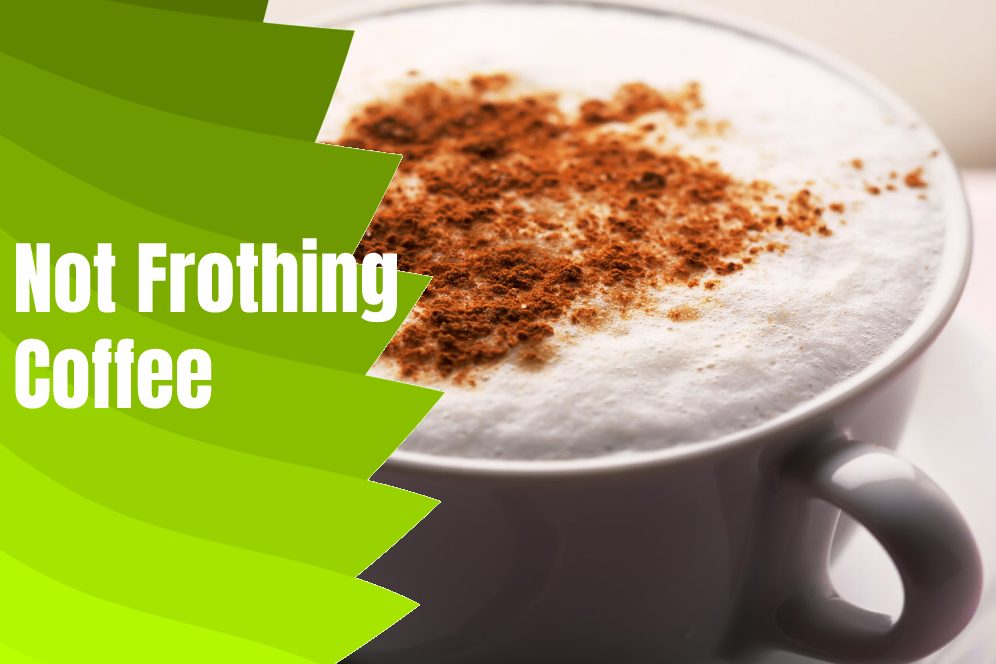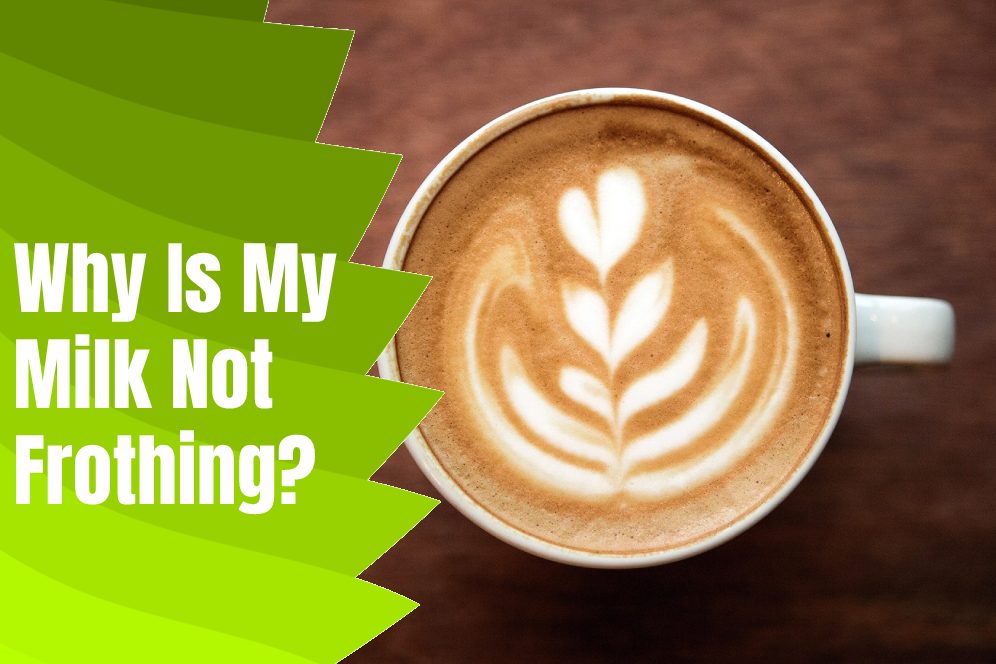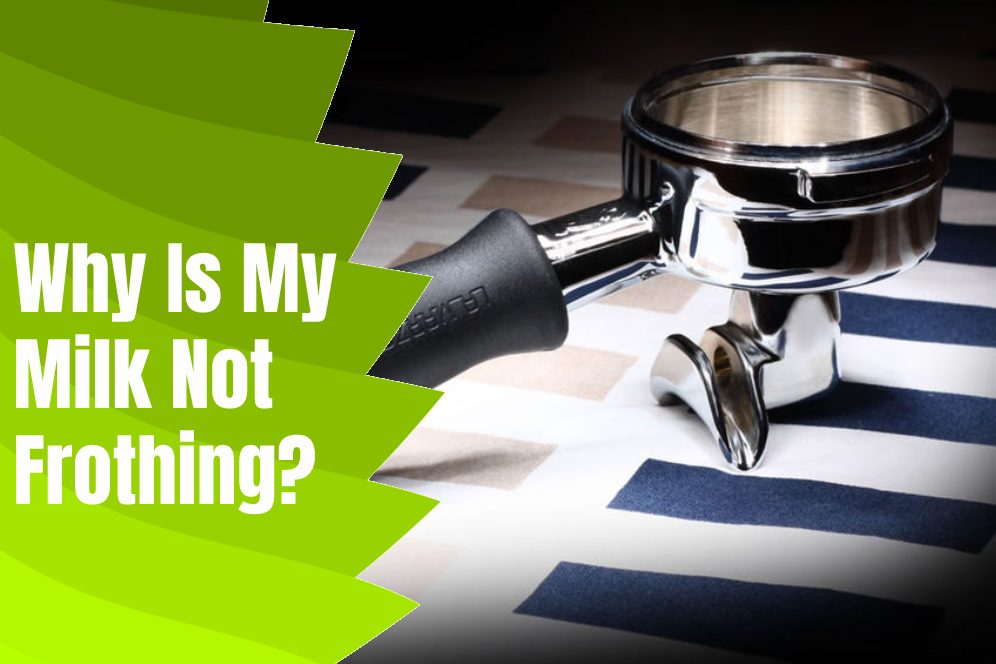How Do I Get More Foam In My Coffee? 8 Reasons For Not Frothing Coffee

Coffee is one of the most popular drinks in the world, promising to kickstart an energetic day. There are numerous ways to prepare coffee, but many aficionados of this beverage relish creating and savoring a delightful, frothy cup.
If you’re a coffee enthusiast, especially one who prefers coffee with a creamy foam, yet no matter how hard you try, you can’t seem to achieve that frothy perfection, this section will elucidate the reasons behind your coffee’s lack of foam.
If you’ve attempted to brew espresso or coffee at home and find yourself wondering why your espresso lacks that coveted froth:
The absence of crema or foam typically indicates stale coffee grounds, incorrect bean grinding, improper water temperature, or inadequate pressure. Sometimes, it simply means you need more practice. Crema is the tan or reddish-brown froth that crowns a shot of espresso.
At a more precise or scientific level, crema comprises minuscule bubbles of carbon dioxide within the coffee compound. The pressure generated during espresso preparation partially breaks down the water, resulting in the formation of these tiny bubbles.
Contents
- 1 Improper water temperature
- 2 Improper coffee (the main cause of coffee not frothing)
- 3 type of coffee
- 4 Type of coffee maker
- 5 Wrong mixing method
- 6 Portafilter
- 7 Low-quality brown selection
- 8 Characteristics of coffee
- 9 extraction time
- 10 Check the temperature of the coffee
- 11 How to make foamy coffee with a Moka pot?
- 12 Frothing Milk at Home
- 13 Milk: Cow, Soy, or Coconut?
- 14 Conclusion
Improper water temperature
The water used in coffee brewing is also very important. The water must be chlorine-free. Also, be careful not to use cold water for frothing the coffee. In order for your coffee to have consistency and foam, the temperature of the initial water you choose to make coffee should be very low. Because this way, the coffee will boil later and foam more.
Improper coffee (the main cause of coffee not frothing)
If the coffee you use is left over and a long time has passed since its roasting date, the coffee will not foam. Coffee that is fresh and very fine has enough consistency and concentration. Also, if your coffee is old (roasted more than a few weeks ago), then it will be much more difficult to get crema or foam.
All the coffees available in the market have an expiration date. When their expiration date passes, they lose their quality. Check whether the coffee you are using is between 2 and 21 days past the roasting date! So, when you buy coffee, make sure it is of good quality.
read more: How To Grind Coffee At Home Without A Grinder?
type of coffee
Turkish coffee, French coffee, and espresso family are different types of coffee. French coffee is like diluted tea and does not have foam and scum at the bottom of the cup. Turkish coffee is thicker than French coffee and thinner than espresso. In Turkish coffee, a layer of relatively thick foam is usually seen. Espresso is the most pure coffee you can drink.
Type of coffee maker
Another reason for the coffee not frothing is related to your coffee maker. If you prepare the coffee in an Ibrik or a coffee pot with a narrow opening, the coffee will not lose its level when the cream rises. In this way, the foam is preserved on the coffee. But if you prepare the coffee in a coffee maker with a very wide mouth and a very large volume, your coffee will not foam.
This TikTok-famous recipe is definitely worth trying: Dalgona coffee.
Wrong mixing method
One of the reasons for not foaming coffee is the wrong coffee mix. To prepare a creamy and frothy Turkish coffee, the percentage of Robusta coffee (70%) should be higher than Arabica (30%).
Portafilter
One of the other reasons for the espresso not foaming is that the filter is cold. Two or more filters are placed inside each of the espresso machines, to prevent the entry of certain materials that are used. A portafilter is a filter that is used to prevent the entry of coffee grounds into the espresso machine. If the Portafilter is too cold, it will affect the water temperature and cause its temperature to decrease. Also, this issue causes no foam or foam on the coffee. To solve this problem, you should put the Portafilter in some warm water and then put it in the espresso machine and use it.
Low-quality brown selection
One of the common reasons for coffee not foaming is using low-quality coffee. Low-quality coffees are usually made from low-quality, unripe beans, which can have a direct impact on the coffee’s flavor and aroma. For the best possible experience, it is recommended to choose fresher and higher-quality coffees.
Characteristics of coffee
Some types of coffee may not foam due to their properties. For example, some local or traditional coffees may not foam due to their preparation process or specific characteristics.
extraction time
The extraction time also directly affects the quality of the coffee. Coffee extraction must be done for a suitable period. Long extraction time can lead to coffee not foaming.
Check the temperature of the coffee
If you are one of the people who don’t want to spend time making coffee and you are in a hurry. Please ignore this coffee! When you put the coffee pot on the gas flame, if you raise the temperature below it and put the flame on high, it will not foam.
Note: Turkish coffee should be prepared on low heat and with enthusiasm. Remove from the heat after the coffee starts to rise and foam. Remember not to let your coffee start to boil as it will cause your coffee to become frothy.
Does the degree of grinding Turkish coffee affect the coffee grounds?
Foam is one of the characteristics of coffee. It is the most important point that gives coffee a special taste. There are several factors that cause the foam to form. The grinding degree of Turkish coffee affects the coffee grounds and also has a direct effect.
The main factor in the formation of foam in coffee is its biological and chemical properties. Raw coffee beans release a large amount of carbon dioxide when roasted. Thanks to its porous structure, the coffee bean traps in its cells some of the carbon dioxide released during roasting.
The carbon dioxide that settles in the cells is released after the roasting process is over. This does not prevent fluctuations, and in fact, the output of carbon dioxide is very important for coffee maturation for a while. Especially in the first week, carbon dioxide emissions occur strongly. This emission is decreasing day by day, but still, a small amount of carbon dioxide remains.
The remaining carbon dioxide is released during the grinding process. As the coffee is divided into smaller pieces, the width of the surface is reduced. The smaller the particle, the faster the release of carbon dioxide. If the coffee beans are ground too fine, this will cause more foam.
How to make frothy coffee, is almost a question of many coffee lovers.
How to make foamy coffee with a Moka pot?
- coffee beans
- Coffee grinder (we recommend an automatic grinder)
- Moka pot
- wet towel
- Water
- A gas stove
How to prepare foamy coffee
- Fill the bottom compartment with cold water. Grind your beans to a fine concentration, until you fill the Moka pot funnel with coffee. Do not use coffee that is too finely ground because it will clog the machine.
- Insert the funnel and fill it with ground coffee. Try not to fill the filter too much with coffee and not stick the coffee.
- Screw the top of the pot firmly to the base.
- Choose the size of the flame that fits the bottom of the Moka pot. Place the Moka pot on the stove until the water boils and the coffee starts to come out of the center post.
- In order to extract the full flavor of espresso, you need to heat it slowly. If the heat is too high, the coffee will begin to “splash” when poured and may taste burnt. But fear not, if this happens, redo the brew and just heat the Moka pot to a slightly lower temperature.
- When the top of the Mokapot is full of coffee and a hazel brown foam comes out of the mouth, remove it from the stove. This froth appears a few seconds before the coffee is fully brewed, so as soon as it appears, your brew is done!
read more: Benefits Of Drinking White Coffee
Frothing Milk at Home
It’s recommended that the milk you intend to froth should be warm. Frothing cold milk at home is more challenging.
These appliances are also useful for frothing coffee at home:
• A small hand or electric frother
• A frothing wand
If you don’t have any of the mentioned tools above, you can assist with milk frothing by heating the milk in the microwave for about half a minute and vigorously shaking it between microwave intervals.
The frothed milk should be flexible and uniformly thick. This is achieved by frothing milk thoroughly; a small frother is a handy tool for this task.
After frothing, swirl the pitcher several times to make the froth consistent and eliminate any air bubbles. You can also tap the frothing pitcher on the table a few times to get rid of the bubbles.
Following frothing, depending on your beverage, pour the milk quickly over your coffee or underneath it.
Milk: Cow, Soy, or Coconut?
If you want to use real cow’s milk, the best milk froth is achieved due to the fat content it contains. Various plant-based milks like oat milk, soy milk, and coconut milk have gained a lot of popularity in recent years. Oat milk, similar to oat milk, can easily create a very good milk froth. On the other hand, soy and coconut milk may not froth as easily, but there are also versions of them available in the market that are specifically designed for frothing. You can get them from well-equipped grocery stores.
Conclusion
Coffee is one of the most popular and delicious drinks around the world, which can be prepared in different ways. Like a latte, cappuccino, espresso, etc. These several types of coffee must be made with advanced devices because they require milk froth or foam. But sometimes, the espresso maker does not foam. Therefore, if you want to know the reason why your espresso machine is not foaming, read this article.
why is my coffee not foaming?
There are a few possible reasons why your coffee is not foaming. The most common reason is that the milk is not cold enough. Cold milk will foam better than warm milk. Additionally, the milk may not have been frothed properly. Make sure to use a proper frothing wand or steamer to ensure the milk is properly frothed. Finally, the type of milk you are using may also affect the foam. Whole milk will foam better than skim milk.
why is my Turkish coffee not foaming?
There are several possible reasons why your Turkish coffee is not foaming. It could be that the grind of the coffee is too coarse, the water is not hot enough, or the coffee was not stirred properly. Additionally, if the coffee has been sitting for too long, the foam may have dissipated.
The lack of foam on the top of your drink indicates a malfunction in the structure of your drink or a problem with your machine.
why is my coffee frothy?
Frothy coffee is usually caused by air bubbles that are created when the coffee is mixed with milk or cream. This can be caused by stirring the coffee too vigorously, using a blender, or using a milk frother.
why is my espresso foamy?
Espresso is foamy because of the pressure used to force the hot water through the coffee grounds. The pressure causes the coffee to release oils and proteins, which create the foam.
how to make espresso martini more frothy?
To make an espresso martini more frothy, you can add a teaspoon of sugar and shake the mixture vigorously for a few minutes. This will help to create a nice foam on top of the drink. You can also use an electric frother to create more foam. Finally, you can add a scoop of ice cream to the mixture before shaking, which will also help to create a nice frothy texture.








Milk foam training was excellent and practical
Creating that perfect coffee foam is an art in itself. It’s incredible how a well-made foam can elevate the overall coffee experience. Whether you’re aiming for a classic cappuccino or a fancy latte, mastering the technique of making coffee foam is essential. From the right milk to the ideal frothing temperature, there are several factors that contribute to achieving that silky, creamy foam. I’d love to hear tips and tricks from fellow coffee enthusiasts on how they create the best coffee foam at home!
If your coffee isn’t foaming as expected, don’t worry, you’re not alone! Achieving the perfect coffee foam can be a bit tricky sometimes. There are several reasons why your coffee might not be foaming as desired. It could be the type of milk you’re using, the temperature, or even the equipment. It’s important to troubleshoot and identify the issue. You might need to adjust the frothing technique, ensure the milk is fresh and at the right temperature, or consider using different milk alternatives if you have dietary preferences. If anyone has experienced this and found a solution, please share your tips to help others get that ideal coffee foam!